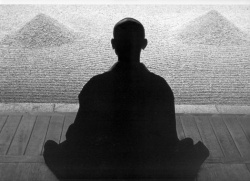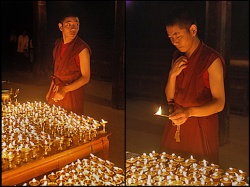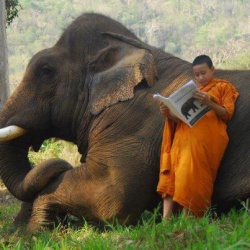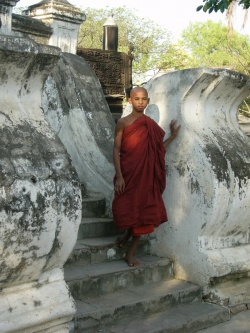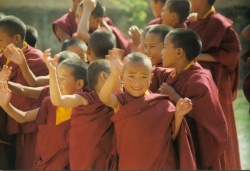Manual of Vinaya - CLASS NOTES part 1
Class One: Course Overview
Introduction:
We study ethics in order to reach nirvana. Nirvana is escaping from samsara; your samsaric condition is caused by your bad thoughts. Your own body and mind are part of samsara. Sooner or later your body will die, and your mind is constantly struggling, without success, to try to maintain a state of satisfaction. The nature of samsara is such that you cannot trust any normal object in this life: you don’t know with any certainty that what you have now you will have next week. There is no certainty about anything, and security doesn’t exist. The state of your mind a week from now is not within your control. This is suffering and it is a part of our nature. Escaping samsara is escaping from that part of our nature. Nirvana is reaching that mental place where you are incapable of having a bad thought ever again no matter what happens to you. You might have pain, but it won’t disturb your peace of mind. And you must perceive emptiness directly to reach nirvana.
The Three Trainings: (presented in reverse order):
3. SHERAB Extraordinary Training of Wisdom, taught in the Abhidharma. It means the direct perception of emptiness.
2. TING NGENDZIN Extraordinary Training of Meditation, taught in the Sutras. It means meditative concentration that has the ability to keep the mind fixated on a holy object. Perfect meditation is like water in a pond that is totally still, no ripples, no movement.
1. TSULTRIM Extraordinary Training of Ethical Living, taught in the vinaya. It means ethical living, morality, being a good person in everyday life. This is like a pond in which the water is perfectly pure and clear. Note that “Extraordinary” refers to Buddhist training aimed at nirvana and Buddhahood. When water in a pond is perfectly clear and totally still, the moon can reflect vividly off of the water. If that thing called emptiness is going to reflect on the surface of your mind, the mind must be totally quiet and pure. In order to be able to reach a deep state of meditation, which is necessary for the direct perception of emptiness, your conscience must be clear. To reach nirvana you must perceive emptiness directly. To perceive emptiness directly you need to achieve a high level of meditation. To reach a high level of meditation you need an ethical way of life.
Morality leads to Concentration which leads to Wisdom
To progress in your meditation practice you must be doing the preliminaries properly, meditating on a holy object for at least an hour every day, and keeping your conscience clear by living an ethical way of life.
Three Different Meanings of “Sutra”:
1. The open teachings of Buddha
2. A short book
3. One of the three great collections of Buddhist scriptures:
Ten Misdeeds:
1. Killing
2. Stealing
4. Lying
5. Divisive talk
6. Harsh words
7. Idle talk
8. Craving others’ possessions or qualities
9. Ill-will
10. Wrong view
Vinaya focuses on misdeeds of body and speech (#1-7), and bodhisattva & secret vows focus on misdeeds of mind.
Kleshas are mental afflictions: any thought which disturbs your peace of mind. The strength of the disturbance corresponds to the strength of the klesha. Even a tiny bad thought, such as a moment of irritation, causes unhappiness. When you get rid of all the kleshas permanently, which depends upon seeing emptiness directly, you have reached nirvana.
The Meaning of “Vinaya”:
Ngulchu Dharma Bhadra said: We call vinaya ‘vinaya’ and we call discipline ‘discipline’ because the subject matter of the scriptures on discipline, which is the seven rules and all their friends, functions to discipline the mental afflictions and also functions to discipline your sense organs. “Dulwa” means “to tame,” as in to tame a wild horse.
DULWA NI TEN DANG TUNPA NGU YIN “If vinaya is taught truly discipline is Buddha’s The Teacher actual is anywhere, I the Buddha, am vinaya Teachings (Buddha) there.” Vinaya itself is enough to represent Buddha and all of
His teachings.
The Two Root Sutras: These two sutras are the ultimate source of vinaya.
GELONG PAY SOTAR GYI DO GELONG MAY SOTAR GYI DO fully ordained monk vowed of sutra fully ordained nun vowed of sutra morality
The Sutra of Vowed Morality for Fully Ordained Monks (PAY)
The Sutra of Vowed Morality for Fully Ordained Nuns (MAY)
DULWAY DO Early Sanskrit commentary, basis for Buddhist discipline in Tibetan Vinaya Sutra monasteries. Written by Master Dharma Bhadra, Loppon Yun-Ten U (500 a.d.). Dulway Do is a Tengyur commentary, not a true Sutra (Open teachings of an Enlightened Being). So sutra here means “short book,” not “Buddha’s words”)
Three Commentaries Used in this Course:
1. DULWA GYATSOY NYINGPO The Essence of the Ocean of Vinaya, a threediscipline ocean, dalai the very essence page summary by Je Tsongkapa (1357-1419).
2. NYIN JE Day Maker (sunshine) by Ngulchu Dharma daytime to make Bhadra (1772-1851). Day Maker sheds light on Je Tsongkapa’s text (above). Dharma Bhadra’s commentary was the basis for Pabongka’s commentary, which is an important work in the Vajrayogini lineage.
3. YISHIN NORBU Wish-Fulfilling Jewel, by Choney Lama wish-fulfilling jewel Drakpa Shedrup (1675-1748). This commentary was missing for 40 years, and was just found recently in St.Petersburg. We will be the first to study this work in modern times.
Class Two: Outline of the Sutra on Discipline
Choney Lama, in the Wish Fulfilling Jewel, explains the whole Vinaya Sutra. This class covers, in outline form, the entire scope of vinaya from beginning to end.
Preliminary Overview:
This section covers the life of Shakyamuni Buddha, describing the process by which the Buddha became a Buddha, outlining the major stages in His spiritual life over a time period of three “countless eons.” It contains an explanation of the two root texts, the four explanatory sutras, all the canonical works on discipline, and their commentaries. An explanation is given for why Lord Buddha said that if we wanted to get the whole essence of Buddhism it would be enough just to have the vinaya scriptures: the teachings of vinaya stand for the teachings of the Buddha. Vinaya addresses good deeds and bad deeds, and this is the subject of LEN-DRE, karma and its consequences. There is a connection between what you think, say, and do, and your whole world. It is useful for a person to know where everything in their world came from. The implication is that you can control your future and fix what you don’t like about it now by leading a moral life. This leads us to the three levels of reality:
Three Levels of Reality: These categories are fluid depending on who the observer is.
1. NYUN GYUR Obvious reality, that level of reality which you can perceive obvious reality directly, for example with your senses. It includes the perception of colors, shapes, etc. You can also directly perceive your thoughts, like when you’re thinking of something directly and not using a process of reasoning. Obvious reality is not the same for everyone. For example, when someone is color blind.
2. KOK GYUR Subtle reality. Reality which is deep enough that it can only deep reality be perceived by a process of logical reasoning for most people. It is not something you could see with your eyes, ears, nose, or hands. For example, at this stage of your development, emptiness is subtle reality—you can only perceive emptiness with reasoning.
3. SHINTU KOK GYUR Extremely subtle reality. For example, the subtlest workings extremely deep reality of karma and its consequences: the real connections between what you think, say, and do and what happens to you as a result. You had tens of thousands of distinct thoughts today and each one of them is going to have its own discrete result. Each thought contributes to your future reality and the reality around you now, which consists of millions of different objects, all of which have been created by different discreet karmas. Only an omniscient being can see the connections between actions of body, speech, and mind, and their consequences.
Actual Explanation of Root Text:
1. TSEN GYI DUN The meaning of the name of the title; an explanation of what “vinaya” and “sutra” mean. Vinaya is called vinaya because you can control two things by studying vinaya: bad thoughts and desire for sense objects.
2. GYUR GYI CHAK Explanation of the translator’s obeisance. The obeisance was a traditional requirement set up by early Tibetan kings in order to identify the subject matter based on whom you were prostrating to. In the vinaya we bow to Buddha because he understands the subtle workings of karma.
3a. GUSOK CHU SHI Commentary upon the root text. This is a common opening for every Buddhist text. It proves that the text is worth studying, that studying this book will be relevant to your reaching nirvana.
3b. Actual Commentary:
i. DOMPA MATOPPA TOPJE Getting the pure lineage vows properly. restrain you don’t how to You should consider that the vows give you wings to the vows have them get them fly if you grow them strong enough, not that they restrict you.
ii. TOPPA MI NYAMPA How to keep the vows from being damaged, after after you keep them from you’ve taken your vows. got vows being broken
Four parts to keeping the vows from being damaged:
a. Relying on an outer support, a monastic preceptor, to help keep your vows: a NE LAMA, or “resident teacher,” who guides a young monk.
b. Relying on an inner support, your own pure intentions: You should remember and always maintain your original motivation for taking the vows. You should think, “This life is suffering, and I am taking these vows to get out of it.”
c. Having a good understanding of the factors that work against them. Know the vows clearly, what constitutes breaking them or not breaking them, and what can be modified.
d. Mastering monastic practices. Three categories:
1. SOJONG The practice of the monks and nuns meeting together twice a month to do purification and confession.
2. YARNE A three-month summer retreat. The sangha stays in a certain area, quietly, and studies scripture and meditates.
3. GALYE Release of summer retreat, a three-week celebration following summer retreat.
iii. NYAM NA CHIR CHUPA How to restore your vows, if they’ve been broken. It includes confession, purification and reconciliation.
Drawing the Wheel of Life:
The section on ancillary points contains a description of how the Wheel of Life, designed by the Buddha to talk about samsara and nirvana, is to be drawn. Vinaya explains how to draw the seven components of that painting. The opening line of this section is:
GOKANG DU KORWAY KORLO O CHA NGAPAR JA O
at the foyer samsara the wheel part five make it
“Put that painting of the wheel of suffering life in the foyer; give it five parts.” Lord Buddha’s seven-part instructions on how to draw the Wheel of Life:
1. CHA NGA Five realms of existence: pleasure beings, human beings, part five animals, craving spirits, hell beings.
2. BARDOWA DZU KYE Bardo beings. Paint them in a chain to represent beings Intermediate miraculous going up and down from realm to realm, dying and being beings birth reborn again and again.
3. DUK SUM Three poisons. The three animals in the middle represent poisons three the three poisons of the mind that make us suffer our whole life. The rooster is liking things ignorantly, the snake is disliking things ignorantly, and the pig is ignorance. The tails of the other two are coming out of the pig’s mouth to signify that because we don’t understand the marriage between ethics and emptiness we behave immorally in order to get what we like and avoid what we don’t like. Then we suffer because we committed misdeeds.
4. YENLAK 12 Twelve Links of dependent origination. Twelve pictures which describe the mechanism which triggers rebirth.
5. TAMCHE MITAKPA NYI KYI SUNG Draw everything in the clutches of whole thing impermanence in the clutches impermanence. This monster represents the fact of your own impermanence which is killing you day by day, moment by moment, from the inside.
6. DAWA The Buddha should be outside the five realms, pointing to a white heavenly body, showing the way to nirvana.
7. TSIKCHE At the bottom of the painting add the two verses:
1. “Take it up (practice) and give it up (samsara). . .”
2. “Smash the Lord of Death like an elephant squashes a reed hut. Anyone who with proper care practices this Dharma which is vinaya/dulwa will be able to leave behind the wheel of rebirth and put an end to all their suffering.”
Class Three: The Vows of Individual Freedom: Prati Moksha
Opening Line of Je Tsongkapa’s Commentary:
OM DE LEK SU GYUR CHIK
“May all living beings achieve temporary happiness and permanent Buddhahood.”
OM is made up of three components—AH, U, M—and these represent in one sound the pure body, speech, and mind of the Buddha in one sound. OM is also a code word for “calling on all Buddhas and Bodhisattvas”.
Buddha’s Body includes His body in paradise, and His body that emanates in countless universes to help any being who has the karma to see Him. Buddha’s Speech is mainly those emanations that speak and explain Dharma to you. Buddha’s Mind is his omniscience, which knows every object in the universe—all past, present, and future in one moment all at the same time.
SO TAR GYI DOMPA Individual Freedom Vows, Pratimoksha vows. This individual freedom of vows is the subject of vinaya: how to get the vows, how to prati – moksha keep the vows, how to fix the vows if they are damaged. Ngulchu Dharma Bhadra says, “They’re called individual freedom vows because those individuals who keep them reach freedom, and those who don’t keep them don’t reach freedom.“
Je Tsongkapa’s Summary of the Essence of Individual Freedom Vows:
NGENJUNG SAMPE GYUJENE SHENMU SHIDANG CHEPA LE DOKPA
renunciation motivation reason why hurt other beings along with its basis from refraining
“Vows of individual freedom are refraining from hurting others and also from the basis of hurting others, and doing so for the reason/motivation of renunciation.”
Ngulchu Dharma Bhadra says that “along with its basis” means the last three non-virtues which are the basis for the other seven: agreeing to refrain from the thought processes that make you hurt others. So the proper motivation for taking freedom vows is being totally fed up with the suffering of this life.
Six Categories that Explain Individual Freedom Vows:
These are from Je Tsongkapa’s text and will be covered in classes three through seven.
NGOWO DANG NI RABYE DANG SOSOY NGUNDZIN
basic nature and categories and individual sets
KYEWAY TEN TONGWAY GYU DANG PEN YUN…
arise, born basis how they’re lost and benefits of keeping
I. Their basic nature (mental or physical)
II. Their categories (how many)
III. Individual sets of vows
IV. What kind of person can grow the vows
V. How the vows can be lost
VI. Benefits of keeping the vows properly
Basic Nature of the Individual Freedom Vows: The basic nature of the individual freedom vows is presented in terms of how each of the four schools of thought explains them.
…DE YANG LU NGAK LE SUKCHEN YIN SHE DUPA…
those vows body & speech karma something physical it is they believe
“Some believe the vows are physical”:
1. Detailist (Vaibashika or Abhidharma schools) is the first, and the lowest, of the four ancient schools of India. They believe that vows are untouchable, invisible physical stuff that permeates your body. Initially, the vows communicate sincere renunciation through tears, etc. But afterward, you have “non-communicating” physical vows (their presence isn’t apparent to observers).
4b. Implication School (Madhyamika Prasangika) is the upper half of the fourth school (Madhyamika or Middle Way), the highest school of Buddhism. They believe the vows are made of physical conceptualizations, that your visualizations are a kind of form with colors and shapes existing as an object outside your mind, and that this is where the vows are; form that is pictured in the mind. The vows are the conceptualization of seeing yourself not thinking, saying or doing anything bad. (Schools 2, 3, and 4a are on the next page.)
This is the view of the other two and a half schools:
…PONGWAY SAMPA GYUNCHAKPA SABUN DANG CHE YINNO SHE…
to give up the intention stream of mental seed continuation of some people say it’s
“Some people say the individual freedom vows are the (mental) intention to give up bad deeds/words, along with the seed/propensity of that intention which resides in the mental stream.”
2. Sutrists (Sautrantika) say the vows exist as a continued intention; when you’re about to act you think, “Oh no, I shouldn’t do that.”
3. The Mind-Only School also says the vows exist as the mental seed, because the vows can be broken during deep meditation.
4a. Independents (Madhyamika Svatantrika) say the vows are the physical conception, the physical restraining of body and speech as you conceive of them in the mind.
Eight Categories of Individual Freedom Vows:
1. NYEN NE One day vows (there are eight components); these last for twentyfour hours. When the sun rises the next morning and you can see lines on your palm, the vows are lost.
2. GE NYEN PA Lifetime Layman’s Vows
3. GE NYEN MA Lifetime Laywoman’s Vows
4. GE TSUL PA Novice Monk’s Vows
5. GE TSUL MA Novice Nun’s Vows
6. GE LOP MA Intermediate Nun’s Vows
7. GE LONG MA Fully-ordained Nun’s Vows (364 vows)
8. GE LONG PA Fully-ordained Monk’s Vows (253 vows)
Class Four: One Day, Lifetime Lay, and Novice Monk Vows
Sets of Individual Freedom Vows: Je Tsongkapa splits the eight vows into two groups: vows that relate to householders, and vows that relate to non-householders:
1. KYIMPAY CHOK KYI DOMPA Three sets of vows relate to those living the householder type that vows family life: the lifetime lay persons’ vows for men and for woman, and one-day vows.
2. RABJUNG CHOK KYI DOMPA Five sets of vows relate to those who have left left family life type that vows family life (ordained monk and nun vows).
One Day Vows:
NYEN NE One-Day Vows. Eight separate commitments: four primary and four secondary. You are trying for a single day to live like a person who doesn’t have any bad thoughts.
Four primary vows:
1. MI TSANG CHU Sexual activity; adultery is the most serious. not clean activity
2. MA JIN LEN Stealing; taking anything that has not been given which is of not taken given any noticeable value.
3. SOK CHU Killing a human or human fetus; Buddhism teaches that life to cut consciousness enters when the sperm meets the egg, and abortion therefore is a serious misdeed.
4. DZUN MA Lying; especially about your spiritual life, and in particular false to speak about seeing emptiness directly.
Four secondary vows:
5. MEL CHE TE Luxurious furniture; using, or enjoying big comforts; not seat, bed expensive lofty living simply.
6. CHANG TUNG Drinking alcohol, using intoxicants; anything natural or beer to drink chemical that lowers your inhibitions.
7. GAR SOK TRENG SOK Dancing, singing, playing music; wearing flower garlands, perfumes, jewelry, cosmetics; these things lower your inhibitions and disturb your meditative concentration.
8. CHI DRO KASE Eating after noon time; makes you feel heavy and disturbs after noon eating meditation.
The reason for taking one-day vows or any other individual freedom vow is to escape samsara, which is a mental state. The goal (in vinaya) is to reach nirvana.
TEKCHEN SO JONG One-day Mahayana vow of purification. This is a Mahayana mahayana repair purify practice. The goal is to get bodhichitta. This Mahayana one-day vow should not be confused with the other one-day vow.
GE NYEN Lifetime Layperson’s Vows. These are easy to keep, and include five serious bad deeds. The five vows are the same for men and women.
1. Killing a human or human fetus.
2. Stealing anything of worth, taking what was not given; includes cheating on taxes, etc.
3. Lying about your spiritual life, especially saying that you saw emptiness directly.
4. Committing adultery, being unfaithful to your spouse or partner, or having sex with another married person.
5. Taking intoxicants. Lord Buddha said that anyone who drinks or serves the amount of alcohol that fits on the tip of a blade of grass is not a Buddhist. This vow includes any type of intoxicant.
Additional part: Never breaking the advices on going for refuge; most specifically not giving up the dharma refuge, the dharma jewel, which refers to hurting other people. The essence of all the advices on refuge is to give up hurting other people. Anytime you instigate anybody to do the above five things it is equal to doing it yourself. The vows actually change your sensitivity to Dharma and your spiritual capacity.
GE TSUL 13 Novice Monk Vows. Lay people cannot be told the individual ordination vows. They fall into three categories:
1. TSAWA SHI Four Primary: sex, stealing, killing, lying (same four as root four One-day Vow).
2. YEN LAK DRUK Secondary Six: handling money; luxury; intoxicants; secondary vows six dancing, etc.; flowers, etc.; eating after noon.
3. LANG DE SUM Three Transgressions: disrespecting the person who gave take transgress three you the vows; keeping your lay appearance; failing to take up a monk’s appearance (wearing robes and keeping short hair).
Class Five: Vows of Full Ordination
Six Steps for Reaching Full Ordination Vows:
The proper reason for taking the individual freedom vows is renunciation. You are tired of suffering, fed up with being unhappy, with having a sick mind. You want to get rid of the mental afflictions forever. This class covers the ideal progression from first taking the layperson’s vows up to taking the full ordination vows. The example is for a woman progressing to fully ordained nun’s vows.
NYE NE PUNTSOK Faultless. The ideal, excellent way of getting to your full ordination problem no perfect vows. This progression occurs in six steps for women:
1. GENYEN MA Lifetime Laywoman’s Vows. Includes five vows and keeping the advices on going for refuge. You are putting all your hope, all your faith and trust in ethical living. The main point is to understand emptiness and why you need to live an ethical way of life.
2. BARMA RABJUNG Commitment to leave the home life. This is not an individual freedom vow per se, but is a step taken before the ordination vows.
3. GE TSUL MA Novice nun’s vows. Four primary, six secondary, and three transgressions.
4. GE LOB MA Intermediate nun’s vows. Generally taken for two years only. In addition to the 13 GETSULMA vows, includes 12 additional commitments:
4a. TSAWAY CHU DRUK More serious; relate to contact with a man, etc. primary things six
4b. JETUN CHU DRUK Less serious; for example, proper diet, digging in secondary things six the ground, etc.
5. TSANG CHU NERNE KYI TSULTRIM Observe celibacy purely. This pure activity keep of morality is not an individual freedom vow, but it purely is a commitment taken before receiving the fully-ordained nun’s vows.
6. GE LONG MA Fully ordained nun’s vows.
TUNGWA DE NGA Five categories into which fully ordained nun’s vows (364) and fall down group five monk’s vows (253) fall. They are in sequence from the most serious to least serious, and are grouped into five categories:
1. PAMPA (8 for nuns, 4 for monks) To lose, be defeated (by the mental to lose afflictions). These are very serious and dangerous.
2. HLAKMA (20 nuns, 13 monks) Remainder, left over. You still have remainder something leftover that you can repair, to get back on track.
3. TUNG JE Downfall. These make you fall down to the lower realms. to fall makes you There are two categories of downfalls:
3a. PANG TUNG (33 nuns, 30 monks) A downfall where you have to give up give up downfall something to make amends, to fix it.
3b. TUNG JE BASHIK (180 nuns, 90 monks) A downfall where you don’t have to downfall simple give up something.
4. SOR SHAK (11 nuns, 4 monks) Must confess individually. individually confess
5. NYE JE (112 nuns, 112 monks) Did a bad thing, which was not excellent. bad did it
SO JONG Confession ceremony. Confessing your broken vows to your Lama and repair purify to other good people is very powerful, very liberating. The quicker you confess it the better, so that the bad seed doesn’t fester and grow. It functions to purify your bad deeds.
Morality is the basis of your spiritual success. Avoiding the ten misdeeds is the engine that drives all spiritual progress. You should examine your vows and ethical conduct every day. You must make a continuous effort to improve in order to progress beyond your present state.
The energy of taking a vow to avoid a certain behavior and then deliberately avoiding it, is much more powerful than simply not doing it because it’s your natural inclination at the moment. Your current natural goodness comes from your past ethical living, and it’s easy to lose this goodness as you get older and the karma that created it wears out.
The quality of your meditative concentration is directly related to keeping your morality purely. If your life is not noticeably improving, it is most likely because you are not regularly focusing on improving your ethical living.
See also
- Manual of Vinaya - Reading One: Je Tsongkapa’s Epistle on Ethics
- Manual of Vinaya - Reading Two: Outline of the Sutra on Discipline (Vinaya Sutra)
- Manual of Vinaya - Reading Three: Introduction to the Vows of Individual Freedom
- Manual of Vinaya - Reading Four: A General Description of the Vows, Part One
- Manual of Vinaya - Reading Five: A General Description of the Vows, Part Two
- Manual of Vinaya - Reading Six: Taking and Keeping the Vows
- Manual of Vinaya - Reading Seven: The Ten Non-Virtues, and their Karmic Results
- Manual of Vinaya - Reading Eight: Introduction to the Steps of the Path
- Manual of Vinaya - Reading Nine: Description of the Lesser Capacity
- Manual of Vinaya - Reading Ten: Description of the Medium and Greater Capacities
- Manual of Vinaya - CLASS NOTES part 1
- Manual of Vinaya - CLASS NOTES part 2
